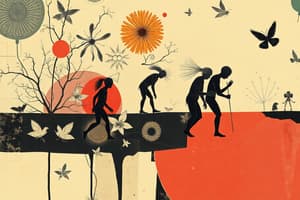Podcast
Questions and Answers
What is the main purpose of photosynthesis in plants?
What is the main purpose of photosynthesis in plants?
- To consume oxygen for energy production.
- To generate carbon dioxide for cellular respiration.
- To convert chemical energy into light energy.
- To produce glucose using light energy. (correct)
Which level of biological hierarchy includes individual living entities?
Which level of biological hierarchy includes individual living entities?
- Organisms (correct)
- Tissues
- Populations
- Cells
In genetics, what does Mendelian inheritance primarily explain?
In genetics, what does Mendelian inheritance primarily explain?
- The composition of the double helix structure of DNA.
- The role of environmental factors in trait expression.
- The inheritance patterns of dominant and recessive alleles. (correct)
- The mechanisms behind asexual reproduction.
Which of the following best describes homeostasis?
Which of the following best describes homeostasis?
Which process produces ATP and utilizes glucose and oxygen?
Which process produces ATP and utilizes glucose and oxygen?
Which process describes how certain organisms survive and reproduce more effectively in their environment?
Which process describes how certain organisms survive and reproduce more effectively in their environment?
What is a key characteristic of model organisms used in biological research?
What is a key characteristic of model organisms used in biological research?
Which of the following is NOT a component of homeostasis in humans?
Which of the following is NOT a component of homeostasis in humans?
What is speciation in the context of evolution?
What is speciation in the context of evolution?
Which of the following microorganisms can play a beneficial role in human health?
Which of the following microorganisms can play a beneficial role in human health?
Study Notes
Overview of Biology
- Definition: Biology is the scientific study of life and living organisms.
- Branches: Includes various fields such as microbiology, botany, zoology, ecology, genetics, and cell biology.
Key Concepts
- Cell Theory: All living organisms are composed of cells; cells are the basic unit of life; all cells arise from pre-existing cells.
- Homeostasis: The ability of an organism to maintain stable internal conditions despite external changes.
- Evolution: Change in the heritable characteristics of biological populations over generations; driven by natural selection.
Biological Hierarchy
- Atoms: Basic units of matter.
- Molecules: Chemical structures made of atoms.
- Cells: Basic unit of life.
- Tissues: Groups of similar cells performing a specific function.
- Organs: Structures made of different types of tissues.
- Organ Systems: Groups of organs that work together.
- Organisms: Individual living entities.
- Populations: Groups of organisms of the same species.
- Communities: Interactions of different species in an area.
- Ecosystems: Communities interacting with their physical environment.
- Biosphere: The global sum of all ecosystems.
Fundamental Biological Processes
- Photosynthesis: Process by which plants, algae, and some bacteria convert light energy into chemical energy (glucose).
- Cellular Respiration: Process that converts glucose and oxygen into energy (ATP), producing carbon dioxide and water.
- Reproduction: The biological process by which new individual organisms are produced; can be sexual or asexual.
Genetics
- DNA Structure: Double helix formed by nucleotides (adenine, thymine, cytosine, guanine).
- Genes: Units of heredity encoded in DNA, responsible for traits.
- Mendelian Genetics: Study of inheritance patterns discovered by Gregor Mendel; includes concepts of dominant and recessive alleles.
Ecology
- Ecosystem Dynamics: Study of interactions between organisms and their environment.
- Biomes: Large geographical biotic communities, such as forests, deserts, and grasslands.
- Food Chains & Webs: Descriptions of energy flow and feeding relationships in ecosystems.
Human Biology
- Body Systems: Includes circulatory, respiratory, digestive, nervous, and muscular systems; each performs vital functions for organism survival.
- Homeostasis in Humans: Examples include temperature regulation, blood glucose levels, and pH balance.
Evolutionary Biology
- Natural Selection: Process whereby organisms better adapted to their environment tend to survive and produce more offspring.
- Speciation: The formation of new and distinct species in the course of evolution.
Microbiology
- Microorganisms: Includes bacteria, viruses, fungi, and protozoa; can be beneficial or pathogenic.
- Importance: Key roles in ecosystems, human health, and industry (e.g., fermentation).
Biological Research Methods
- Observation and Experimentation: Key techniques used to study living organisms.
- Model Organisms: Species used for research, like fruit flies (Drosophila), mice, and zebrafish, due to their genetic similarity to humans.
Conclusion
- Biology encompasses a diverse range of studies focused on understanding life, organisms, and their interactions within the ecosystem. It's fundamental to addressing health, environmental, and ecological challenges.
Overview of Biology
- Biology is the scientific study of life and living organisms.
- It encompasses various branches like microbiology, botany, zoology, ecology, genetics, and cell biology.
Key Concepts
- Cell Theory: All living organisms are made up of cells, which are the basic unit of life and arise from pre-existing cells.
- Homeostasis: Organisms maintain a stable internal environment despite external changes.
- Evolution: Change in heritable traits of populations over generations, driven by natural selection.
Biological Hierarchy
- Atoms: The basic units of matter.
- Molecules: Formed by combining atoms, these are chemical structures.
- Cells: The fundamental unit of life, composed of various molecules.
- Tissues: Groups of similar cells that work together for a specific function.
- Organs: Composed of multiple tissues that work together to perform a complex function.
- Organ Systems: Groups of organs that collaborate to maintain the overall function of the organism.
- Organisms: Individual living entities.
- Populations: Groups of organisms of the same species that live in the same area.
- Communities: Interactions between different populations in a specific area.
- Ecosystems: Communities interacting with their physical environment.
- Biosphere: The sum of all ecosystems on Earth.
Fundamental Biological Processes
- Photosynthesis: Plants, algae, and some bacteria convert light energy into chemical energy (glucose) using this process.
- Cellular Respiration: This process breaks down glucose and oxygen to produce energy (ATP), releasing carbon dioxide and water.
- Reproduction: Organisms produce new individuals through either sexual reproduction (involving two parents) or asexual reproduction (involving a single parent).
Genetics
- DNA Structure: DNA consists of two strands forming a double helix, made up of nucleotides (adenine, thymine, cytosine, guanine).
- Genes: Segments of DNA that carry the instructions for building and maintaining an organism; they are responsible for traits.
- Mendelian Genetics: Gregor Mendel's studies on inheritance patterns revealed concepts like dominant and recessive alleles.
Ecology
- Ecosystem Dynamics: The study of interactions between organisms and their environment.
- Biomes: Large geographical regions characterized by climate and dominant vegetation (e.g., forests, deserts, grasslands).
- Food Chains & Webs: These illustrate the energy flow and feeding relationships within ecosystems.
Human Biology
- Body Systems: Different organ systems (circulatory, respiratory, digestive, nervous, muscular) perform vital functions for survival.
- Homeostasis in Humans: Maintenance of stable conditions like temperature regulation, blood sugar levels, and pH balance.
Evolutionary Biology
- Natural Selection: Organisms better adapted to their environment tend to survive and reproduce more, leading to changes in populations over time.
- Speciation: The process by which new species evolve from existing ones.
Microbiology
- Microorganisms: These include bacteria, viruses, fungi, and protozoa, and they can be beneficial or harmful.
- Importance: Microorganisms play crucial roles in ecosystems, human health, and industries like fermentation.
Biological Research Methods
- Observation and Experimentation: These are key techniques used to study living organisms.
- Model Organisms: Species like fruit flies, mice, and zebrafish are used in research due to their genetic similarities to humans.
Conclusion
- Biology aims to understand life, organisms, and their interactions within the intricate web of ecosystems. It plays a vital role in tackling challenges related to health, the environment, and ecology.
Studying That Suits You
Use AI to generate personalized quizzes and flashcards to suit your learning preferences.
Description
Explore the fundamental concepts and branches of biology in this quiz. Test your knowledge on cell theory, homeostasis, evolution, and the biological hierarchy. Perfect for students looking to strengthen their understanding of life sciences.




